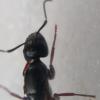I will be presenting my exit seminar for my Master's in Entomology this Thursday December 2nd at 10am eastern. Here is the title and my abstract.
I will take ZEISS' advice and say: If you want to attend send me a Private Message and I will share the link and logon information.
If you attend have your microphone OFF and also your camera OFF. You will have to grant permission when the request comes since it is going to be recorded and that is standard in Zoom in such situations that unless permission is granted you may not enter the Zoom presentation. There will be an opportunity for questions at the end, if you want to ask a question please keep it within the context of the talk, thanks!
TITLE: A Phylogenetic Comparative Analysis of Tapinoma sessile (Say) in Eastern Tennessee with a Description of a New Species of Tapinoma
ABSTRACT:
The odorous house ant (Tapinoma sessile [Say], Hymenoptera: Formicidae: Dolichoderinae) is a commonly encountered nuisance pest ant in eastern Tennessee and much of the nation. Endemic to the U.S., northern Mexico, and southern Canada, this morphologically nondescript ant’s broad geographical distribution within many ecosystems raises questions about (1) its adaptive capacity to climate and elevation, and (2) whether possible cryptic species exist. Adaptive convergence occurs when selection causes different populations to share phenotypic expressions. I employed a phylogenetic comparative method to examine adaptive convergence to extrinsic elevational and climatic traits and intrinsic morphological variation in eastern Tennessee populations of T. sessile. I generated an inferred phylogeny using a mitochondrial cytochrome oxidase gene COI, standard myrmecological morphological measurements, and three software programs, OUwie, SURFACE, and extendedSurface, to explore adaptive convergence in populations. Cytochrome oxidase I sequences from T.sessile reported from outside my collecting areas were obtained from GenBank to explore a larger continental inferred phylogeny and population relationships with elevation and climate. I determined that T.sessile has adaptive convergence to elevation and climate and that haplotypes in eastern Tennessee and North America are more varied than previously reported. My comparison of 14 worker, 22 male, and 22 female characters, revealed significant morphological variation within eastern Tennessee populations of T. sessile. In addition, a sympatric novel species of Tapinoma, superficially similar to T. sessile, was discovered. This new species, designated Tapinoma heleni sp. nov., has a significantly lower number of mandibular teeth and denticles and displays a distinctly different colony structure than T. sessile. This study suggests that Tapinoma sessile has the potential to be a significant temperate invasive due to its adaptive capacity to various elevational and climatic regimes and is most likely capable of adapting to predicted changes in climate. The discovery of the sympatric T. heleni sp. nov. suggests that Tapinoma described as T. sessile may be separate species warranting a more thorough review of curated specimens and greater attention to taxonomic assignment. Tapinoma heleni was only detected in natural areas; thus, its pest status is not known at this time.
Edited by PurdueEntomology, November 29 2021 - 2:34 PM.



















